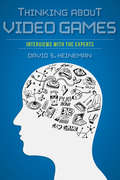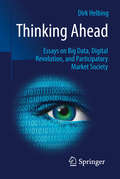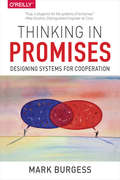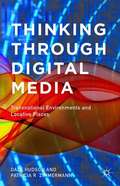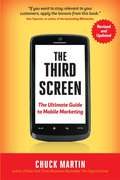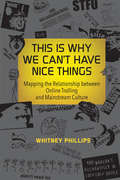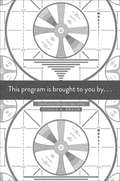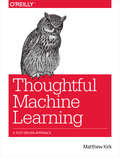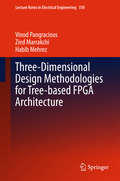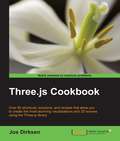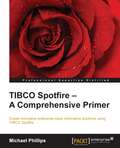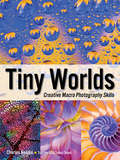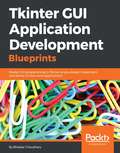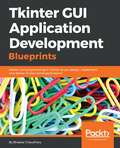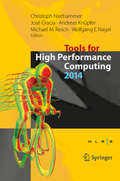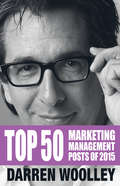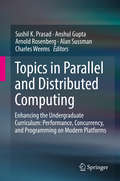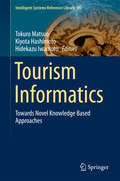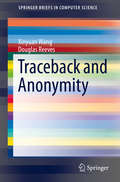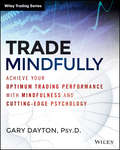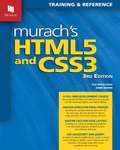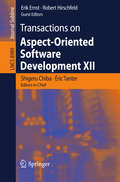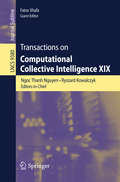- Table View
- List View
Thinking about Video Games
by David S. HeinemanThe growth in popularity and complexity of video games has spurred new interest in how games are developed and in the research and technology behind them. David Heineman brings together some of the most iconic, influential, and interesting voices from across the gaming industry and asks them to weigh in on the past, present, and future of video games. Among them are legendary game designers Nolan Bushnell (Pong) and Eugene Jarvis (Defender), who talk about their history of innovations from the earliest days of the video game industry through to the present; contemporary trailblazers Kellee Santiago (Journey) and Casey Hudson (Mass Effect), who discuss contemporary relationships between those who create games and those who play them; and scholars Ian Bogost (How to Do Things With Videogames) and Edward Castronova (Exodus to the Virtual World), who discuss how to research and write about games in ways that engage a range of audiences. These experts and others offer fascinating perspectives on video games, game studies, gaming culture, and the game industry more broadly.
Thinking Ahead - Essays on Big Data, Digital Revolution, and Participatory Market Society
by Dirk HelbingThe rapidly progressing digital revolution is now touching the foundations of the governance of societal structures. Humans are on the verge of evolving from consumers to prosumers, and old, entrenched theories – in particular sociological and economic ones – are falling prey to these rapid developments. The original assumptions on which they are based are being questioned. Each year we produce as much data as in the entire human history - can we possibly create a global crystal ball to predict our future and to optimally govern our world? Do we need wide-scale surveillance to understand and manage the increasingly complex systems we are constructing, or would bottom-up approaches such as self-regulating systems be a better solution to creating a more innovative, more successful, more resilient, and ultimately happier society? Working at the interface of complexity theory, quantitative sociology and Big Data-driven risk and knowledge management, the author advocates the establishment of new participatory systems in our digital society to enhance coordination, reduce conflict and, above all, reduce the “tragedies of the commons,” resulting from the methods now used in political, economic and management decision-making. The authorPhysicist Dirk Helbing is Professor of Computational Social Science at the Department of Humanities, Social and Political Sciences and an affiliate of the Computer Science Department at ETH Zurich, as well as co-founder of ETH’s Risk Center. He is internationally known for the scientific coordination of the FuturICT Initiative which focuses on using smart data to understand techno-socio-economic systems. “Prof. Helbing has produced an insightful and important set of essays on the ways in which big data and complexity science are changing our understanding of ourselves and our society, and potentially allowing us to manage our societies much better than we are currently able to do. Of special note are the essays that touch on the promises of big data along with the dangers...this is material that we should all become familiar with!” Alex Pentland, MIT, author of Social Physics: How Good Ideas Spread - The Lessons From a New Science "Dirk Helbing has established his reputation as one of the leading scientific thinkers on the dramatic impacts of the digital revolution on our society and economy. Thinking Ahead is a most stimulating and provocative set of essays which deserves a wide audience.” Paul Ormerod, economist, and author of Butterfly Economics and Why Most Things Fail. "It is becoming increasingly clear that many of our institutions and social structures are in a bad way and urgently need fixing. Financial crises, international conflicts, civil wars and terrorism, inaction on climate change, problems of poverty, widening economic inequality, health epidemics, pollution and threats to digital privacy and identity are just some of the major challenges that we confront in the twenty-first century. These issues demand new and bold thinking, and that is what Dirk Helbing offers in this collection of essays. If even a fraction of these ideas pay off, the consequences for global governance could be significant. So this is a must-read book for anyone concerned about the future." Philip Ball, science writer and author of Critical Mass “This collection of papers, brought together by Dirk Helbing, is both timely and topical. It raises concerns about Big Data, which are truly frightening and disconcerting, that we do need to be aware of; while at the same time offering some hope that the technology, which has created the previously unthought-of dangers to our privacy, safety and democracy can be the means to address these dangers by enabling social, economic and political participation and coordination, not possible in the past. It makes for compelling reading and I hope for timely action.”Eve Mitleton-Kelly, LSE, author of Corporate Governance and Complexity Theory and editor of Co-evolution of Intelligent Socio-
Thinking Functionally With Haskell
by Richard BirdRichard Bird is famed for the clarity and rigour of his writing. His new textbook, which introduces functional programming to students, emphasises fundamental techniques for reasoning mathematically about functional programs. By studying the underlying equational laws, the book enables students to apply calculational reasoning to their programs, both to understand their properties and to make them more efficient. The book has been designed to fit a first- or second-year undergraduate course and is a thorough overhaul and replacement of his earlier textbooks. It features case studies in Sudoku and pretty-printing, and over 100 carefully selected exercises with solutions. This engaging text will be welcomed by students and teachers alike.
Thinking in Promises: Designing Systems for Cooperation
by Mark BurgessImagine a set of simple principles that could help you to understand how parts combine to become a whole, and how each part sees the whole from its own perspective. If such principles were any good, it shouldn't matter whether we're talking about humans on a team, birds in a flock, computers in a datacenter, or cogs in a Swiss watch. A theory of cooperation ought to be pretty universal, so we should be able to apply it both to technology and to the workplace.Such principles are the subject of Promise Theory, and the focus of this insightful book. The goal of Promise Theory is to reveal the behavior of a whole from the sum of its parts, taking the point of the parts rather than the whole. In other words, it is a bottom-up, constructionist view of the world. Start Thinking in Promises and find out why this discipline works for documenting system behaviors from the bottom-up.
Thinking Through Digital Media
by Dale Hudson Patricia R. ZimmermannThinking through Digital Media offers a means of conceptualizing digital media by looking at projects that think through digital media, migrating between documentary, experimental, narrative, animation, video game, and live performance. Hudson and Zimmermann analyze projects at the intersections of imbedded technologies, transitory micropublics, human-machine interface, and critical cartographies to forward a set of speculations about how things work together rather than what they represent. The book frames debates on participation/surveillance, outsourcing, global warming, migrations, GMOs, and war across some of the most dynamic, innovative sites for digital media, including Brazil, Canada, China, Germany, India, Indonesia, Italy, Kenya, Nigeria, Palestine, Saudi Arabia, Singapore, and the United States.
The Third Screen, New Edition: The Ultimate Guide To Mobile Marketing
by Chuck MartinThe Ultimate Guide to Mobile Marketing - Revised and UpdatedAn American Express Open Forum Best Business BookWe are in the midst of a technological revolution bigger than the television or the PC. How do we, as marketers, harness mobile technology to serve our customers most effectively?With the "first screen"-the television-companies sent ads directly into consumers' living rooms, reaching millions with one campaign. The "second screen"-the personal computer-increased interaction between companies and consumers and allowed for immediate customer feedback. Now, the "third screen"-the mobile device-changed the game in an even more revolutionary way. The Third Screen: The Ultimate Guide to Mobile Marketing defines the implications, strategies, and tactics used to thrive in business during the mobile revolution. This revised, updated paperback links technological developments to behavioral changes, reveals the unexpected forces of thechanges in mobile, and equips marketers and businesses for the future.A new breed of consumer has emerged: on the go and always on, tapping into content at the touch of a button-anytime, anywhere.
This Book Loves You
by PewDiePieThis Book Loves You by PewDiePie is a collection of beautifully illustrated inspirational sayings by which you should live your life. If you follow each and every one, your life will become easier, more fabulous, more rewarding. Imagine what a chilled-out and wonderful human being people would think you were if you lived by the simple principle "You can never fail if you never try." Your wasted life would be an inspiration to others. Think of all the pointless, unhappy striving you could simply give up. Throw away that guitar! Give up on your dreams! Embrace your astounding mediocrity. This Book Loves You has something for everyone--or at least everyone willing to give up and stop caring. If all else fails, remember: "Don&’t be yourself. Be a pizza. Everyone loves pizza."
This Is Why We Can't Have Nice Things: Mapping the Relationship between Online Trolling and Mainstream Culture (The\mit Press Ser.)
by Whitney PhillipsWhy the troll problem is actually a culture problem: how online trolling fits comfortably within today's media landscape.Internet trolls live to upset as many people as possible, using all the technical and psychological tools at their disposal. They gleefully whip the media into a frenzy over a fake teen drug crisis; they post offensive messages on Facebook memorial pages, traumatizing grief-stricken friends and family; they use unabashedly racist language and images. They take pleasure in ruining a complete stranger's day and find amusement in their victim's anguish. In short, trolling is the obstacle to a kinder, gentler Internet. To quote a famous Internet meme, trolling is why we can't have nice things online. Or at least that's what we have been led to believe. In this provocative book, Whitney Phillips argues that trolling, widely condemned as obscene and deviant, actually fits comfortably within the contemporary media landscape. Trolling may be obscene, but, Phillips argues, it isn't all that deviant. Trolls' actions are born of and fueled by culturally sanctioned impulses—which are just as damaging as the trolls' most disruptive behaviors. Phillips describes, for example, the relationship between trolling and sensationalist corporate media—pointing out that for trolls, exploitation is a leisure activity; for media, it's a business strategy. She shows how trolls, “the grimacing poster children for a socially networked world,” align with social media. And she documents how trolls, in addition to parroting media tropes, also offer a grotesque pantomime of dominant cultural tropes, including gendered notions of dominance and success and an ideology of entitlement. We don't just have a trolling problem, Phillips argues; we have a culture problem. This Is Why We Can't Have Nice Things isn't only about trolls; it's about a culture in which trolls thrive.
This Program Is Brought to You By...
by Joshua A. BraunJournalism, television, cable, and online media are all evolving rapidly. At the nexus of these volatile industries is a growing group of individuals and firms whose job it is to develop and maintain online distribution channels for television news programming. Their work, and the tensions surrounding it, provide a fulcrum from which to pry analytically at some of the largest shifts within our media landscape. Based on fieldwork and interviews with different teams and organizations within MSNBC, this multi-disciplinary work is unique in its focus on distribution, which is rapidly becoming as central as production, to media work.
Thoughtful Machine Learning
by Matthew KirkLearn how to apply test-driven development (TDD) to machine-learning algorithms--and catch mistakes that could sink your analysis. In this practical guide, author Matthew Kirk takes you through the principles of TDD and machine learning, and shows you how to apply TDD to several machine-learning algorithms, including Naive Bayesian classifiers and Neural Networks.Machine-learning algorithms often have tests baked in, but they can't account for human errors in coding. Rather than blindly rely on machine-learning results as many researchers have, you can mitigate the risk of errors with TDD and write clean, stable machine-learning code. If you're familiar with Ruby 2.1, you're ready to start.Apply TDD to write and run tests before you start codingLearn the best uses and tradeoffs of eight machine learning algorithmsUse real-world examples to test each algorithm through engaging, hands-on exercisesUnderstand the similarities between TDD and the scientific method for validating solutionsBe aware of the risks of machine learning, such as underfitting and overfitting dataExplore techniques for improving your machine-learning models or data extraction
Three-Dimensional Design Methodologies for Tree-based FPGA Architecture
by Vinod Pangracious Zied Marrakchi Habib MehrezThis book focuses on the development of 3D design and implementation methodologies for Tree-based FPGA architecture. It also stresses the needs for new and augmented 3D CAD tools to support designs such as, the design for 3D, to manufacture high performance 3D integrated circuits and reconfigurable FPGA-based systems. This book was written as a text that covers the foundations of 3D integrated system design and FPGA architecture design. It was written for the use in an elective or core course at the graduate level in field of Electrical Engineering, Computer Engineering and Doctoral Research programs. No previous background on 3D integration is required, nevertheless fundamental understanding of 2D CMOS VLSI design is required. It is assumed that reader has taken the core curriculum in Electrical Engineering or Computer Engineering, with courses like CMOS VLSI design, Digital System Design and Microelectronics Circuits being the most important. It is accessible for self-study by both senior students and professionals alike.
Three.js Cookbook
by Jos DirksenThis book is ideal for anyone who already knows JavaScript and would like to get a broad understanding of Three.js quickly, or for those of you who have a basic grasp of using Three.js but want to really make an impact with your 3D visualizations by learning its advanced features. To apply the recipes in this book you don't need to know anything about WebGL; all you need is some general knowledge about JavaScript and HTML.
TIBCO Spotfire – A Comprehensive Primer
by Michael PhillipsIf you are a business user or data professional, this book will give you a solid grounding in the use of TIBCO Spotfire. This book assumes no prior knowledge of Spotfire or even basic data and visualization concepts.
Tiny Worlds
by Charles NeedleSuccessful nature photographer and lecturer Charles Needle often asks students in his workshops if they understand the difference between "looking" and "seeing". The difference he is pointing out is that while we are constantly "looking" at countless people, places and things, we might not be actually seeing what is right in front of us. Being tuned into this difference can elevate your art as a photographer, allowing you to be more in tune with your surroundings. Needle has applied this concept to his work and it shows. Utilizing macro photography to capture the nuances of the nature all around us. In this extensive handbook, Needle covers not only his philosophy for seeing and capturing nature photography but delves into the equipment he uses. Needle covers composition, flash techniques, the fundamentals of macro photography and so much more. The book features many set-up shots, equipment shots and sequential shots detailing the progression towards creating the final images. This essential text provides both the inspiration and the technique required to beautifully capture the wonders of nature.
Tkinter GUI Application Development Blueprints
by Bhaskar ChaudharyMaster GUI programming in Tkinter as you design, implement, and deliver ten real-world applications from start to finish About This Book * Conceptualize and build state-of-art GUI applications with Tkinter * Tackle the complexity of just about any size GUI application with a structured and scalable approach * A project-based, practical guide to get hands-on into Tkinter GUI development Who This Book Is For Software developers, scientists, researchers, engineers, students, or programming hobbyists with basic familiarity in Python will find this book interesting and informative. People familiar with basic programming constructs in other programming language can also catch up with some brief reading on Python. No GUI programming experience is expected. What You Will Learn * Get to know the basic concepts of GUI programming, such as Tkinter top-level widgets, geometry management, event handling, using callbacks, custom styling, and dialogs * Create apps that can be scaled in size or complexity without breaking down the core * Write your own GUI framework for maximum code reuse * Build apps using both procedural and OOP styles, understanding the strengths and limitations of both styles * Learn to structure and build large GUI applications based on Model-View-Controller (MVC) architecture * Build multithreaded and database-driven apps * Create apps that leverage resources from the network * Learn basics of 2D and 3D animation in GUI applications * Develop apps that can persist application data with object serialization and tools such as configparser In Detail Tkinter is the built-in GUI package that comes with standard Python distributions. It is a cross-platform package, which means you build once and deploy everywhere. It is simple to use and intuitive in nature, making it suitable for programmers and non-programmers alike. This book will help you master the art of GUI programming. It delivers the bigger picture of GUI programming by building real-world, productive, and fun applications such as a text editor, drum machine, game of chess, media player, drawing application, chat application, screen saver, port scanner, and many more. In every project, you will build on the skills acquired in the previous project and gain more expertise. You will learn to write multithreaded programs, network programs, database driven programs and more. You will also get to know the modern best practices involved in writing GUI apps. With its rich source of sample code, you can build upon the knowledge gained with this book and use it in your own projects in the discipline of your choice. Style and approach An easy-to-follow guide, full of hands-on examples of real-world GUI programs. The first chapter is a must read as it explains most of the things you need to get started with writing GUI programs with Tkinter. Each subsequent chapter is a stand-alone project that discusses some aspects of GUI programming in detail. These chapters can be read sequentially or randomly depending upon the readers experience with Python.
Tkinter GUI Application Development Blueprints
by Bhaskar ChaudharyGeometry Management, Event Handling, and more Key Features A Practical, guide to learn the application of Python and GUI programming with tkinter Create multiple cross-platform real-world projects by integrating host of third party libraries and tools Learn to build beautiful and highly interactive user interfaces, targeting multiple devices. Book Description Tkinter is the built-in GUI package that comes with standard Python distributions. It is a cross-platform package, which means you build once and deploy everywhere. It is simple to use and intuitive in nature, making it suitable for programmers and non-programmers alike. This book will help you master the art of GUI programming. It delivers the bigger picture of GUI programming by building real-world, productive, and fun applications such as a text editor, drum machine, game of chess, audio player, drawing application, piano tutor, chat application, screen saver, port scanner, and much more. In every project, you will build on the skills acquired in the previous project and gain more expertise. You will learn to write multithreaded programs, network programs, database-driven programs, asyncio based programming and more. You will also get to know the modern best practices involved in writing GUI apps. With its rich source of sample code, you can build upon the knowledge gained with this book and use it in your own projects in the discipline of your choice. What you will learn -A Practical, guide to help you learn the application of Python and GUI programming with Tkinter - Create multiple, cross-platform, real-world projects by integrating a host of third-party libraries and tools - Learn to build beautiful and highly interactive user interfaces, targeting multiple devices. Who this book is for This book is for a beginner to intermediate-level Pythonists who want to build modern, cross-platform GUI applications with the amazingly powerful Tkinter. Prior knowledge of Tkinter is required.
Tools for High Performance Computing 2014
by Christoph Niethammer José Gracia Andreas Knüpfer Michael M. Resch Wolfgang E. NagelNumerical simulation and modelling using High Performance Computing has evolved into an established technique in academic and industrial research. At the same time, the High Performance Computing infrastructure is becoming ever more complex. For instance, most of the current top systems around the world use thousands of nodes in which classical CPUs are combined with accelerator cards in order to enhance their compute power and energy efficiency. This complexity can only be mastered with adequate development and optimization tools. Key topics addressed by these tools include parallelization on heterogeneous systems, performance optimization for CPUs and accelerators, debugging of increasingly complex scientific applications and optimization of energy usage in the spirit of green IT. This book represents the proceedings of the 8th International Parallel Tools Workshop, held October 1-2, 2014 in Stuttgart, Germany - which is a forum to discuss the latest advancements in the parallel tools.
Top 50 Marketing Management Posts of 2015: The Marketing Management Book of the Year
by Darren WoolleyWith over 240 pages, this year's Marketing Management Book of the Year is a must read for any marketer grappling with the fast-paced environment of today's marketing. 2015 is a third year in a row that TrinityP3 has published the Top 50 Marketing Management Posts and it continues to grow in popularity and prominence amongst the marketing, procurement and advertising industry. Covering a wide range of hot marketing topics from digital marketing to agency management, procurement, production and everything in between. All the contributors are subject matter experts with more than 10 years industry experience, giving practical insight into the complex world of marketing. But what is the marketing industry saying about Top 50 Marketing Management Posts 2015? Darren Woolley's Top 50 Marketing Management Post of the Year is a remarkable mosaic of must-read articles and expert opinions that will open your mind, offer new perspectives and challenge you in the process. Bruno Gralpois, Author of "Agency Mania" and Co-Founder and Principal, Agency Mania SolutionsI consider theft a great compliment and I admit that I've been stealing great ideas from Darren Woolley for years. Darren's unique and forthright industry perspective comes from a deep understanding of the needs of both advertisers and agencies. It is rare to get such an insightful holistic perspective on the issues and opportunities that shape today's fast paced marketing industry. Peter Levitan, Author of "Buy this Book. Win more pitches" and Boss, Peter Levitan & Co.Darren Woolley is a true industry thought leader who has inspired me on countless occasions with his insights and unique points-of-view. Trinity P3's Top 50 Marketing Management Posts is an incredibly valuable collection that will inspire you, too. A must-read for anyone in this ever-changing, increasingly difficult-to-navigate industry. Barry Wacksman, Co-Author of "Connected by Design" and EVP, Global Chief Strategy Officer, R/GADarren's 'book of blog" articles is an essential read for any marketer who wants to open their mind to what could be. His points of view often challenge our way of thinking. He provides perspectives that deviate from the status quo, which can initiate some very productive discussions. I have had the pleasure of conversation and debate with Darren over the years and I am richer for it. Susan Charles, Vice President, Association of Canadian AdvertisersDarren's strength is that he always acknowledges the elephant in the room. In so doing, he provides vibrant, provocative, action-oriented ideas, alternatives, solutions and thought leadership on the expanding remit that is marketing. If change is the constant Darren's posts are a valuable tool for currency and content for today's marketers. Sunita Gloster, Chief Executive Officer, Australian Association of National Advertisers
Topics in Parallel and Distributed Computing: Introducing Concurrency In Undergraduate Courses
by Charles Weems Alan Sussman Arnold Rosenberg Anshul Gupta Sushil K. PrasadThis book introduces beginning undergraduate students of computing and computational disciplines to modern parallel and distributed programming languages and environments, including map-reduce, general-purpose graphics processing units (GPUs), and graphical user interfaces (GUI) for mobile applications. The book also guides instructors via selected essays on what and how to introduce parallel and distributed computing topics into the undergraduate curricula, including quality criteria for parallel algorithms and programs, scalability, parallel performance, fault tolerance, and energy efficiency analysis. The chapters designed for students serve as supplemental textual material for early computing core courses, which students can use for learning and exercises. The illustrations, examples, and sequences of smaller steps to build larger concepts are also tools that could be inserted into existing instructor material. The chapters intended for instructors are written at a teaching level and serve as a rigorous reference to include learning goals, advice on presentation and use of the material, within early and advanced undergraduate courses. Since Parallel and Distributed Computing (PDC) now permeates most computing activities, imparting a broad-based skill set in PDC technology at various levels in the undergraduate educational fabric woven by Computer Science (CS) and Computer Engineering (CE) programs as well as related computational disciplines has become essential. This book and others in this series aim to address the need for lack of suitable textbook support for integrating PDC-related topics into undergraduate courses, especially in the early curriculum. The chapters are aligned with the curricular guidelines promulgated by the NSF/IEEE-TCPP Curriculum Initiative on Parallel and Distributed Computing for CS and CE students and with the CS2013 ACM/IEEE Computer Science Curricula.
Tourism Informatics
by Tokuro Matsuo Kiyota Hashimoto Hidekazu IwamotoThis book introduces new trends of theory and practice of information technologies in tourism. The book does not handle only the fundamental contribution, but also discusses innovative and emerging technologies to promote and develop new generation tourism informatics theory and their applications. Some chapters are concerned with data analysis, web technologies, social media and their case studies. Travel information on the web provided by travelers is very useful for other travelers make their travel plan. A chapter in this book proposes a method for interactive retrieval of information on accommodation facilities to support travelling customers in their travel preparations. Also an adaptive user interface for personalized transportation guidance system is proposed. Another chapter in this book shows a novel support system for the collaborative tourism planning by using the case reports that are collected via Internet. Also, a system for recommending hotels for the users is proposed and evaluated. Other chapters are concerned with recommendation, personalization and other emerging technologies.
Traceback and Anonymity
by Douglas Reeves Xinyuan WangThis brief systematically examines the trackback problem and its interaction with low-latency anonymous communication. First, it provides an overview of the common techniques a network-based attack may use to hide its origin and identity. Then the authors explore the MIX-based anonymity and the building blocks of low-latency anonymous communication. Later chapters offer a comprehensive study of the timing attacks on low-latency anonymous communication, and analyze the fundamental limitations of low-latency anonymous communication from the perspective of timing-based covert channel. Suitable for professionals and researchers, Traceback and Anonymity is a close look at a key aspect of cyber security studies. Advanced-level students interested in cyber security techniques or networking will also find the content valuable.
Trade Mindfully: Achieve Your Optimum Trading Performance with Mindfulness and Cutting Edge Psychology
by Gary DaytonOvercome psychological obstacles to increase trading success<P><P> Successful traders need to be well-versed and skilled in a wide range of business and economic areas. But now, in addition to effective trading strategies and sound money management techniques, traders need to possess the know-how to handle the mental and emotional challenges of working in a highly volatile environment. Trade Mindfully is a unique resource that applies cutting-edge psychological techniques to trading skills, allowing readers to improve their mental outlooks and maximize the potential of their trading strategies. This book draws upon recent psychological research in behaviorism to teach new approaches that call for better focus, more confidence, and more positive perspectives and outcomes.<P> One of the key concepts covered in the book is mindfulness, a state of mind traditionally touted in the East for its ability to reduce stress and increase perspective, useful qualities for traders looking to rise above emotional obstacles and the poor results they cause. The author also discusses the importance of High Value Trading Actions (HVAs), specific actions that are under a trader's control. With this guide, trading professionals will be able to form solid strategies based on a combination of these notions and practices, leading to higher levels of trading performance.<P> * Applies sound psychological practice and evidence-based research to the trading profession<P> * Covers the psychological perspectives and mental skills needed to succeed in today's trading world<P> * Focuses on key concepts that lead to deliberate practice, specific trading activities, and increased awareness and focus<P> * Designed to help traders deal with the emotional challenges that come with uncertainty and risk<P> Trade Mindfully touches on the most essential concepts for anyone intrigued by what trading psychology has to offer, and delivers the best strategies for achieving the right mental skills for peak performance.
Training and Reference: Murach's HTML5 and CSS3 (3rd Edition)
by Zak Ruvalcaba Anne BoehmSo whether you're a web designer, a JavaScript programmer, a server-side programmer, or a rookie, this book delivers the HTML/CSS coding skills you need today. It begins with an 8-chapter hands-on course that teaches you HTML5 and CSS3 from scratch, showing you how you can't use one without the other nowadays. This quick-start course ends with a chapter that teaches you how to use Responsive Web Design (RWD) so your pages will look good and work right on any screen, from phone to tablet to desktop and beyond. In fact, you ll learn more about RWD in this one chapter than you can in many full books on the subject! After that, you can go on to any other chapter in the book to learn new skills whenever you need them. For example, you can learn how to enhance a site with audio and video clips, forms with HTML5 data validation, or CSS3 transitions and animations. You can see how to use JavaScript and jQuery to add features like accordions, tabs, and slide shows to a page, or to create a mobile site when a responsive site is impractical. You can learn the principles of web design, as well as how to deploy your finished sites. And no matter what, you can use the book as a time-saving reference whenever you have a question about HTML and CSS.
Transactions on Aspect-Oriented Software Development XII
by Shigeru Chiba Éric Tanter Erik Ernst Robert HirschfeldThe LNCS journal Transactions on Aspect-Oriented Software Development is devoted to all facets of aspect-oriented software development (AOSD) techniques in the context of all phases of the software life cycle, from requirements and design to implementation, maintenance and evolution. The focus of the journal is on approaches for systematic identification, modularization, representation, and composition of crosscutting concerns, i. e. , the aspects and evaluation of such approaches and their impact on improving quality attributes of software systems. This volume, the 12th in the Transactions on Aspect-Oriented Software Development series, contains one regular paper, on modular reasoning in aspect-oriented languages from a substitution perspective, and four extended, improved papers selected from those presented at Modularity 2014. Topics covered include novel dynamic semantics through delegation proxies, modularity potential detection based on co-change clusters, improvements in reusability for components of semantic specifications of programming languages, and probabilistic model checking applied to dynamically generated members of a product line.
Transactions on Computational Collective Intelligence XIX
by Fatos Xhafa Ryszard Kowalczyk Ngoc Thanh NguyenThesetransactions publish research in computer-based methods of computationalcollective intelligence (CCI) and their applications in a wide range of fieldssuch as the semantic Web, social networks, and multi-agent systems. TCCIstrives to cover new methodological, theoretical and practical aspects of CCIunderstood as the form of intelligence that emerges from the collaboration and competitionof many individuals (artificial and/or natural). The application of multiplecomputational intelligence technologies, such as fuzzy systems, evolutionarycomputation, neural systems, consensus theory, etc. , aims to support human andother collective intelligence and to create new forms of CCI in natural and/orartificial systems. This nineteenth issue contains 11 carefully selected andrevised contributions.
